|
The Dead Cities:
The so called "Dead Cities" are found in the elevated limestone country between the Orontes and Afrin Rivers to the west and the Aleppo/Hama highway to the east. Approximately 20 - 40 km in width, the zone spreads over a much greater length covering most of 140 km between Cyrrhus in the north and Apamea in the south. 
It contains one of the great archaeological puzzles of this century. Nonetheless this area provides a rich source of insight into Roman and Byzantine rural life, since it lived along the first ten centuries AD on fertile lands.
Al Bara:
In terms of size and variety of remains, this is one of the most impressive of the dead cities.
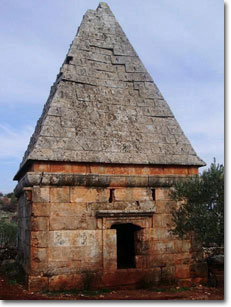 Extending over an area of 6 Km sq. is the dead city of Al Bara, often considered one of the most important and beautiful in Syria. It is situated 35 Km south of Idleb on the western slopes of Al Zawiye Mountain and is at a height of 700 meters above sea level. Extending over an area of 6 Km sq. is the dead city of Al Bara, often considered one of the most important and beautiful in Syria. It is situated 35 Km south of Idleb on the western slopes of Al Zawiye Mountain and is at a height of 700 meters above sea level.
The importance of the settlement resulted from its location between the two major sections of Jebel Zawiye, the trough in which it is located forming a north/south corridor essential for internal access. The settlement of Al Bara only began in the fourth century as a Byzantium state.
Settlement in Al Bara began in the 4th century as a center for the production of olive oil and wine. It expanded in the 5th and 6th centuries to become
one of the largest of the Byzantine cities in the area, and became the processing center for many of the surrounding villages. The building style at Al Bara gives an idea of the prosperity it enjoyed, and by the end of the Byzantine era it included 5 churches that are still recognizable and pyramid-roofed tombs that are interesting to see. 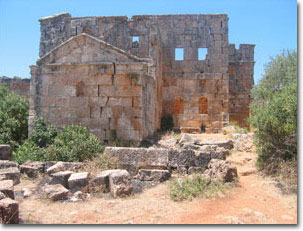
It was left alone during the Muslim conquests of Syria and was taken over by the Crusaders in 1098 by the Count of Toulouse who replaced the presiding Bishop with a Latin one. In 1123 it fell to the Muslims who strengthened the defensive system by building Qalaat Abu Sufian.
The main vestiges at Al lude the pyramidal roofed tombs that are carefully engraved with acanthus leave decorations, the five churches dating back to the 5th and 6th centuries and are beautiful examples of Byzantine basilicas, and the Muslim fort of Qalaat Abu Sufian.
Serjila: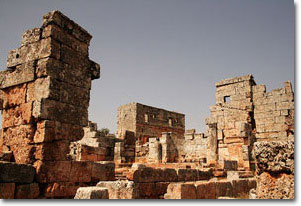
One of the most famous dead cities in the region is that of Serjila. It is located about 7 km from Al Bara, and is famous for the beautiful remains of Roman baths.
Situated in a natural basin at the bottom of the Eastern slope of the Ariha Mountain, it is the remains of a complete Byzantine settlement including remains of houses, baths, tombs and a church. The existence of baths in this region shows how prosperous this region had been. This region was rich in vine and it was a center for its cultivation and the production of wine. 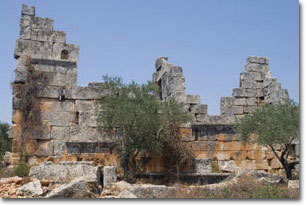
The floor of these baths dates back to 473, and is some of the most preserved in Syria. A large mosaic was found in the main meeting hall of the baths, by an American expedition and has since been destroyed.
The church at Serjila dates back to 372, although begun a little earlier and is considered one of the oldest in the region. Also found at Serjila are the extensive remains of houses, and the terraces on the slopes around it, where stones used to keep the vine in place, can still be seen. Kharab Shams:
There are a few remains (including a rock-cut tomb and lintels) which reveal the origins of the settlement before the classical period.
The remains are being cursorily built in polygonal, not dressed, stones. Villas appeared during the Christian period. The village perhaps owes most of its interest to the dominant ruins on the southern edge of the settlement, a fourth century church that is worthy to visit. 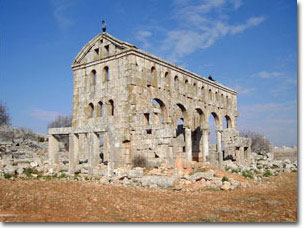
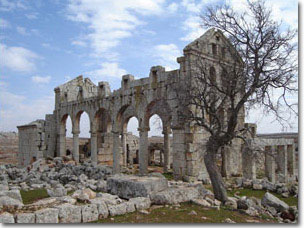 |


